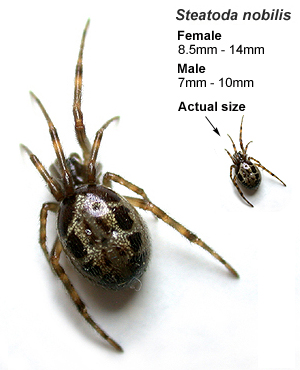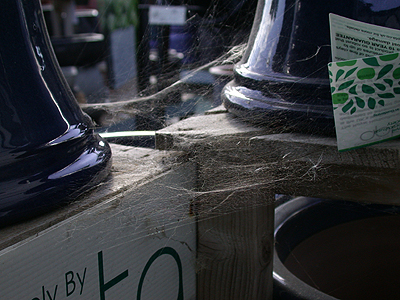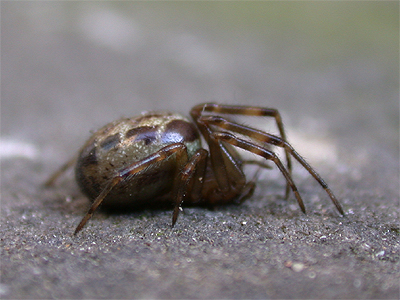

| The arrival of Steatoda nobilis in Nottinghamshire | ||
| ...... |
| The arrival into and colonisation
of the UK by invertebrates found widely over the
Continent, is by no means an irregular occurrence and
over the past century, the UK species list has risen by
literally hundreds as a result. Our invertebrate fauna is constantly changing as new species move in and existing species decline and eventually die out, although the two are not usually as a direct consequence of each other. The trend towards increasingly milder Winters over the past few decades has allowed invertebrates normally found in much warmer countries to take up residence here and one former Canary Islands resident did that over a century ago and has just made it to sunny Nottinghamshire. 'Nobility' arrives in Nottinghamshire Continued range expansion into inland counties of the UK is often surprisingly rapid from arrival points on the south coast and as species spread north, inland counties such as Nottinghamshire, Derbyshire and Leicestershire get their share of new arrivals. |
 |
|
| ...... | ||
| One of Nottinghamshire's most recent arrivals is especially notable for its notoriety. Steatoda nobilis (the Noble False Widow) is a spider that is notorious for all the wrong reasons, as its one of the UK's most venomous spiders with a supposed reputation for biting people. Bites can be painful and are said to be similar to a Bee or Wasp sting, but usually just provide the bitten with a degree of fame and possibly some fortune, when they appear in the newspapers under some ridiculously frightening headline. |
| ...... | ||
 |
If you have read the last
paragraph and by now only remember the words 'spider' and
'venomous', then you're most likely to have a phobia of
spiders and may well have been taken in by the nonsense
reported on the TV and in the newspapers. Incorrect, sensationalist reporting has done Steatoda nobilis no favours and to be honest, neither has the grossly exaggerated over-reaction of a proportion of the general public. Many invertebrates are extremely difficult to identify correctly and spiders are certainly one of the most difficult - even difficult enough for experts to have to examine specimens under a microscope by correctly identify many species. So how come the public can identify them so easily? In truth, the answer is that they can't and most bites attributed to Steatoda nobilis, were clearly caused by something else and there's a whole list of potential possibilities and causes, before we would even get to Steatoda nobilis. |
|
| ...... | ||
| The Spider
Recording Scheme in their species account for S.
nobilis state that "bites to humans are
unlikely to happen in normal circumstances, since the
spiders are usually confined to their web in cracks in
walls or under window sills. The bite in most people
would be little different to a bee sting and there are
currently few definite recorded occurrences in Britain
since 1979, many reports almost certainly being the
result of non-spider related causes, which have
incorrectly been assumed to be the result of False Widows".
With only a handful of documented bites proved to have been caused by Steatoda nobilis (confirmed by retention and later identification of the specimen) in well over a century, this is hardly cause to 'demonise' the spider the way it has been by the TV and Press. Incorrect, ill-informed and scaremongering comments on social media do not help either and it is difficult to get accurate information listened to, or read by the spider fearing public. In truth, you are far more likely to become ill through human contact at home, than be bitten and made ill by Steatoda nobilis. Yes it can bite if severely provoked, but it is unlikely ever to do so and any bite will really be down to severe provocation. From the specimens we have kept for a few days in captivity recently, it is a docile species and when encountered will quickly drop out of its web retreat and run if disturbed, rather than stand and defend. The first Nottinghamshire records of Steatoda nobilis Steatoda nobilis has been in the UK since for well over a century and is abundant in many parts of southern England. In recent years, there has been a gradual northwards spread but records from most Midlands counties are still unusual. It is usually found around the outside of buildings and houses (rarely indoors), where it builds a substantial 'scaffold' web (shown above) with a tubular retreat partially hidden within a crack or crevice. The web differs from other Steatoda species on the strength of its silk, being noticeably stronger. |
||
| ...... |
| Nottinghamshire's first
record came from Attenborough Nature Reserve on September
17th 2016, when one was found under an interpretation
panel by assistant reserve manager Tim Sexton during a
Bat walk. The specimen was eventually collected and
retained and the following morning, Tim was able to
photograph the spider and confirm that it was an immature
female Steatoda nobilis. To be certain of his original identification, Tim emailed his photographs to local spider recorder Howard Williams, who then forwarded them on to Peter Harvey from the Spider Recording Scheme. Both agreed with Tim's original identification and confirmed that it was the first record for Nottinghamshire. Steatoda nobilis reached Leicestershire in 2014, so it was really only a matter of time before it appeared in Nottinghamshire. We had looked for the spider ourselves for several years and we always believed it to be in the county somewhere. A couple of years ago, a photograph of S. nobilis claimed to have been taken in Newark, appeared on Facebook. It wasn't on a wildlife related page, so was accompanied by the usual negative comments. Our appeal for further information to back up the record/claim, failed to get any response and we still regard the record as probably being a good one. |
 |
|
| ............ | ||
Like many invertebrates, Spiders are easily assisted in expansion of their range and the horticultural trade is accountable for the introduction of many native and non-native species. Indeed, Uloborus plumipes (the Feather-legged Lace Weaver) was accidentally introduced into the UK via the house plant trade in 1990 and is now so common that it is present indoors at probably all local garden centres now. And in the very south of Nottinghamshire, there is a small, self-sustaining colony of Argiope bruennichi (the Wasp Spider) at one garden centre. Additional county records There are other invertebrates and spiders which are best looked for around any site where stock change-over is frequent, so it really should not have been a surprise when Steatoda nobilis turned up at a second Nottinghamshire site within two weeks of the county's first record. On September 30th, we visited the Dukeries Garden Centre between Mansfield and Worksop. Found initially by their webs and suspecting something interesting on the strength of the web, we soon potted up a mature male and an immature female following a little shelf rummaging, but a larger female eluded capture by quickly dropping out of her retreat and was lost. The webs were constructed on some outdoor display stands and were plentiful. There is obviously a healthy population around the site and one which has clearly been accidentally introduced unlike the Attenborough record, which has to be regarded as genuine (unassisted) range expansion. Further Steatoda nobilis records have followed and it is likely that it is now found at many sites, scattered widely across Nottinghamshire. Garden Centres are worth searching, as apart from the Dukeries Garden Centre near Worksop, we recorded it from Brookfields Garden Centre at Mapperley, before finding it in and around a conservatory at a house on Gretton Road a mile or so away. Just over the Nottinghamshire border with Derbyshire, Steatoda nobilis is present at the Garden Centre at Shirebrook. In 2019, it was reported from a hotel at Retford. |